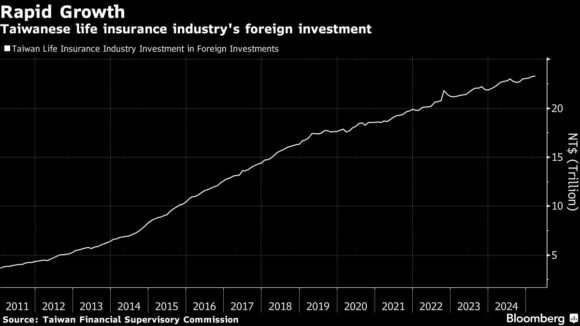For decades, Taiwan’s life insurance companies boasted of above-average returns from their heavy investment in US bonds. That reliance is now a major risk threatening more than $700 billion of assets.
Unlike insurers in other countries like Japan where diversification is the norm, Taiwanese firms have more than 90% of their overseas assets denominated in the dollar. This puts them at risk of a long-term decline in the US currency as the appeal of American exceptionalism wanes.
Worse, there are few signs that the $1.2 trillion industry is ready for a major overhaul of its investment model given the limited size of the local financial market and a habitual dependence on regulatory support when times are tough. That means the sector’s $4 billion currency loss between January and April and some of its biggest players’ worsening earnings woes may only mark the start of more shocks, raising questions of systemic risks to the island’s finances and retirement savings.
More broadly, the woes of Taiwan’s insurers are a reminder of the predicament that plagues many export-oriented economies with large surpluses but limited domestic investment opportunities. It also trains the spotlight on the Asian exporter’s efforts to maintain a competitive exchange rate — an issue that has periodically drawn Washington’s scrutiny and a key focus of speculation over the island’s trade talks with the US.
“Taiwan is an extreme case on the size of the lifers’ foreign bond portfolio, the scale of the unhedged book and the concentration in US dollars,” said Brad Setser, a senior fellow at the Council on Foreign Relations. “The Taiwan central bank’s long history of smoothing volatility and at times blocking all appreciation through significant intervention clearly has created the perception that holding dollars unhedged doesn’t pose large risks.”
Now worth 1.5 times Taiwan’s economy, the industry has enjoyed a two-decade boom thanks to deregulation and an aging population. The number of firms has ballooned to more than 20 from just two in the 1940s, according to official data.
The combination of a small local bond market, a tightly managed exchange rate and consistently higher US interest rates have prompted the insurers to flock to the world’s biggest debt market to seek yield. Their incessant demand for US dollars also in turn reduces the need for Taiwan’s central bank to use intervention to suppress the value of its currency.


